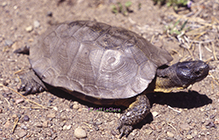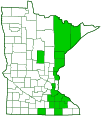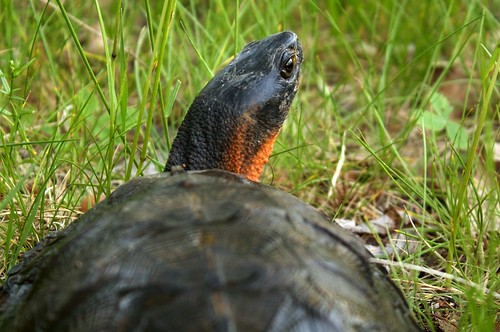Wood Turtle
(Glyptemys insculpta)
Conservation • Description • Habitat • Biology • Distribution • Taxonomy
|
|
||||||||||||||
Description |
Wood turtle is a medium-sized, long-lived turtle. Males eventually attain a larger size than females. The upper shell (carapace) is low, broad, and 5½″ to 8″ long, rarely up to 9″ long. It is dark grayish-brown or brownish-gray and has a low longitudinal keel. It has the appearance and feel of wood, giving this species its common name. It is composed of hard, overlapping scales (scutes) that have a sculpted appearance, giving this turtle its species name. Each scute is keeled and has a dark central blotch surrounded by concentric, light yellow, annual growth rings. The larger scales also show yellow and dark lines radiating from the center. On some individuals, the scutes are conspicuously keeled and have a flattened pyramidal shape. On older individuals they may be worn smooth. The lower shell (plastron) is yellowish and has a V-shaped notch near the tail. It is not hinged. Each scute has a large dark blotch on the outer edge, at least at the rear corner. On males the plastron is slightly concave. On females it is flat or slightly convex. The head is black, occasionally with some light speckling. Males have larger, wider heads than females. The scales on the upper surface of the legs are black or mottled brown. The skin on the chin, throat, and lower surface of the legs is yellowish or yellowish-orange and pale, sometimes with dark speckling. In the eastern United States the coloration is darker and orange, orangish-red, or salmon-red. The male has a longer, thicker tail than the female. |
Size |
Carapace length: 5½″ to 8″ |
Similar Species |
Blanding’s Turtle (Emydoidea blandingii) adults have a smooth carapace. The plastron is hinged, allowing it to completely close its shell. The chin is bright yellow with no speckling. |
Habitat |
Clear rivers and streams with deep pools and hard bottoms adjacent to a forest or woodland. |
Biology |
Behavior |
This turtle is both aquatic and terrestrial. In the spring fall it is found at the edges of rivers and streams. In the summer it spends most of its time on land, often far, though rarely more than 500 feet, from a river or stream. In October or November it burrows into mud at the bottom of a stream or river where the water will remain unfrozen through the winter. |
Lifespan |
30 to 42 years, possibly longer |
Life Cycle |
Unlike many other turtles, Wood Turtles do not bury themselves in mud to overwinter. They require clean flowing water from which they can extract oxygen throughout the winter. As the temperature drops in November, they rest in pools at the bottom of a river or stream, in log jams, under bank overhangs, or other areas where they can be protected from predators and flood surges. They enter into a state of sluggishness, inactivity, and torpor (brumation), similar to hibernation in mammals, that lasts until the following April. In May or June the female lays a clutch of usually 5 to 13 eggs in a nest she has excavated in a sandy site near moving water. Mortality from predation, mostly by raccoons, is very high and few eggs hatch. Surviving eggs hatch in 47 to 69 days in late August or September. Hatchlings do not overwinter in the nest. Wood turtles are late maturing, reaching sexual maturity at 14 to 16 years. |
Food |
Opportunistic omnivore. Mostly plant matter, including berries, leaves. Also mushrooms, insects, mollusks, earthworms, and carrion. |
Distribution |
||
|
Sources |
|
| 6/19/2024 | ||
Occurrence |
||
|
||
Taxonomy |
|
Class |
Reptilia (Reptiles) |
Order |
Testudines (turtles and tortoises) |
Suborder |
Cryptodira (hidden-necked turtles) |
Superfamily |
Testudinoidea |
Family |
Emydidae (pond and box turtles) |
Subfamily |
Emydinae |
Genus |
Glyptemys (bog and Wood Turtles) |
Wood turtle was formerly classified as Clemmys insculpta. |
|
Subordinate Taxa |
|
|
|
Synonyms |
|
Chelopus insculptus Clemmys insculpta Emys inscripta Emys speciosa Emys speciosa levigata Testudo insculpta |
|
Common Names |
|
Wood Turtle |
|
Glossary
Brumation
Winter dormancy in reptiles. A cold-induced period of sluggishness, inactivity, and torpor in reptiles, akin to hibernation in mammals, but they stir occasionally to drink water.
Carapace
The hard, upper (dorsal), shell-like covering (exoskeleton) of the body or at least the thorax of many arthropods and of turtles and tortoises. On crustaceans, it covers the cephalothorax. On spiders, the top of the cephalothorax made from a series of fused sclerites.
Plastron
The hard, lower (ventral), shell-like covering (exoskeleton) of the body of turtles and tortoises.
Scute
A hard, external scale that forms part of the exoskeleton; as on the belly of a snake, the upper and lower shells of hard-shelled turtles, and the foot of a bird.
Visitor Photos |
||
Share your photo of this reptile. |
||
This button not working for you? |
||
Jeff LeClere |
||
 |
|
|
MinnesotaSeasons.com Photos |
||
|
||
|
||

Slideshows |

Visitor Videos |
||
Share your video of this reptile. |
||
This button not working for you? |
||
Jarek Martineau |
Wood Turtle 01 |
About
Wood Turtle (Glyptemys insculpta) poor little fella almost got ran over in the parking lot at a popular fishing hole, so I moved him to the edge and let him on his way to the way he was going with less vehicle traffic. Video by Jarek Martineau |
Other Videos |
||
Wood Turtle (Glyptemys insculpta) |
About
Published on Mar 13, 2013 Wood Turtle profile: |
Wood Turtle (Glyptemys insculpta) - June 21, 2012 - Hebron (Amston), Connecticut |
About
Published on Jun 21, 2012 Found in the middle of a heavily traffic'd commuter route; relocated to similar (and contiguous) habitat far from roads along the Air Line rail trail. Still images here: http://www.performance-vision.com/airline2012/airline-summer-12a.htm |
Wood Turtle - HD Mini-Documentary |
About
Published on Jan 21, 2013 I found several Wood Turtles on my bike ride from Washington, DC to Pittsburgh. They are an interesting species that enjoy spending time on land as well as in the water. How big are they? What do they eat? Who are their predators? Tune in and learn more about this fascinating animal. Transcript: "The Wood Turtle is characterized by the orangish-red coloring on its neck and legs. The shell on a turtle's back is called the carapace. The Wood Turtle's carapace is defined by a central ridge running along it's back and a wooden appearance. Hence the name. As the turtle grows older the pyramidal ridges on the carapace will grow worn. These creatures are known to live up to 40 years in the wild. Males don't reach sexual maturity until they are 14 to 18 years old. Adults are between 5 and a half to 9 inches long. These turtles can be found in the northeastern United States, southeastern Canada and as far west as Minnesota. This reptile is semi-terrestrial. It prefers small, clear streams with compacted or sandy bottoms, but ventures out of the water to forage for food. It is an omnivore with a wide-ranging diet. However, this turtle prefers to eat animal matter -- especially earthworms and slugs, but also including other small insects, snails, crayfish & carrion. When animals aren't available, it will also eats a large variety of plants, and is very fond of berries. These animals are diurnal, which means they are active during the day and sleep at night. They live in fear of skunks, foxes and several other predators, but their number one predator is the raccoon. If you see one of these slow-moving creatures in the wild. Please let it be. Their population is in decline and they need all the help they can get. Don't take turtles, take pictures." |
North American Wood Turtle |
About
Published on Aug 18, 2013 One of the most fascinating turtles. If you have been lucky enough to meet one in the wild it's a treat since there is fear they may soon disappear. |

Visitor Sightings |
||
Report a sighting of this reptile. |
||
This button not working for you? |
||
Jarek Martineau |
Location: Forbes MN poor little fella almost got ran over in the parking lot at a popular fishing hole, so I moved him to the edge and let him on his way to the way he was going with less vehicle traffic. |
|
| Jeff LeClere 1966 |
Location: St Louis County |
MinnesotaSeasons.com Sightings |
||

Created: Last Updated: © MinnesotaSeasons.com. All rights reserved. |


